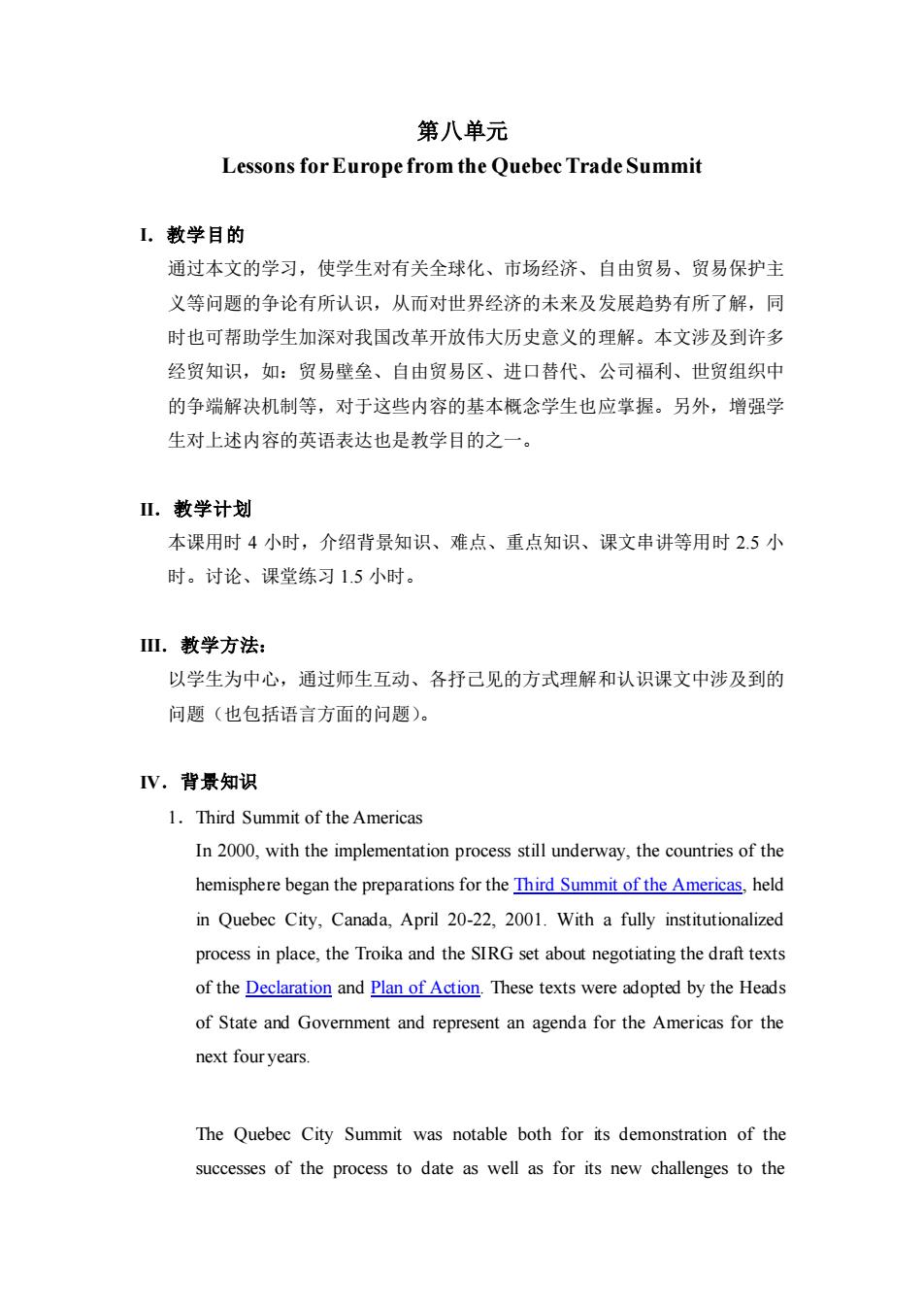
第八单元 Lessons for Europe from the Quebec Trade Summit L.教学目的 通过本文的学习,使学生对有关全球化、市场经济、自由贸易、贸易保护主 义等问题的争论有所认识,从而对世界经济的未来及发展趋势有所了解,同 时也可帮助学生加深对我国改革开放伟大历史意义的理解。本文涉及到许多 经贸知识,如:贸易壁垒、自由贸易区、进口替代、公司福利、世贸组织中 的争端解决机制等,对于这些内容的基本概念学生也应掌握。另外,增强学 生对上述内容的英语表达也是教学目的之一。 Ⅱ.教学计划 本课用时4小时,介绍背景知识、难点、重点知识、课文串讲等用时2.5小 时。讨论、课堂练习1.5小时。 Ⅲ.教学方法: 以学生为中心,通过师生互动、各抒己见的方式理解和认识课文中涉及到的 问题(也包括语言方面的问题)。 V.背景知识 1.Third Summit of the Americas In 2000,with the implementation process still underway,the countries of the hemisphere began the preparations for the Third Summit of the Americas,held in Quebec City,Canada,April 20-22,2001.With a fully institutionalized process in place,the Troika and the SIRG set about negotiating the draft texts of the Declaration and Plan of Action.These texts were adopted by the Heads of State and Government and represent an agenda for the Americas for the next four years. The Quebec City Summit was notable both for its demonstration of the successes of the process to date as well as for its new challenges to the
第八单元 Lessons for Europe from the Quebec Trade Summit I.教学目的 通过本文的学习,使学生对有关全球化、市场经济、自由贸易、贸易保护主 义等问题的争论有所认识,从而对世界经济的未来及发展趋势有所了解,同 时也可帮助学生加深对我国改革开放伟大历史意义的理解。本文涉及到许多 经贸知识,如:贸易壁垒、自由贸易区、进口替代、公司福利、世贸组织中 的争端解决机制等,对于这些内容的基本概念学生也应掌握。另外,增强学 生对上述内容的英语表达也是教学目的之一。 II.教学计划 本课用时 4 小时,介绍背景知识、难点、重点知识、课文串讲等用时 2.5 小 时。讨论、课堂练习 1.5 小时。 III.教学方法: 以学生为中心,通过师生互动、各抒己见的方式理解和认识课文中涉及到的 问题(也包括语言方面的问题)。 IV.背景知识 1.Third Summit of the Americas In 2000, with the implementation process still underway, the countries of the hemisphere began the preparations for the Third Summit of the Americas, held in Quebec City, Canada, April 20-22, 2001. With a fully institutionalized process in place, the Troika and the SIRG set about negotiating the draft texts of the Declaration and Plan of Action. These texts were adopted by the Heads of State and Government and represent an agenda for the Americas for the next four years. The Quebec City Summit was notable both for its demonstration of the successes of the process to date as well as for its new challenges to the
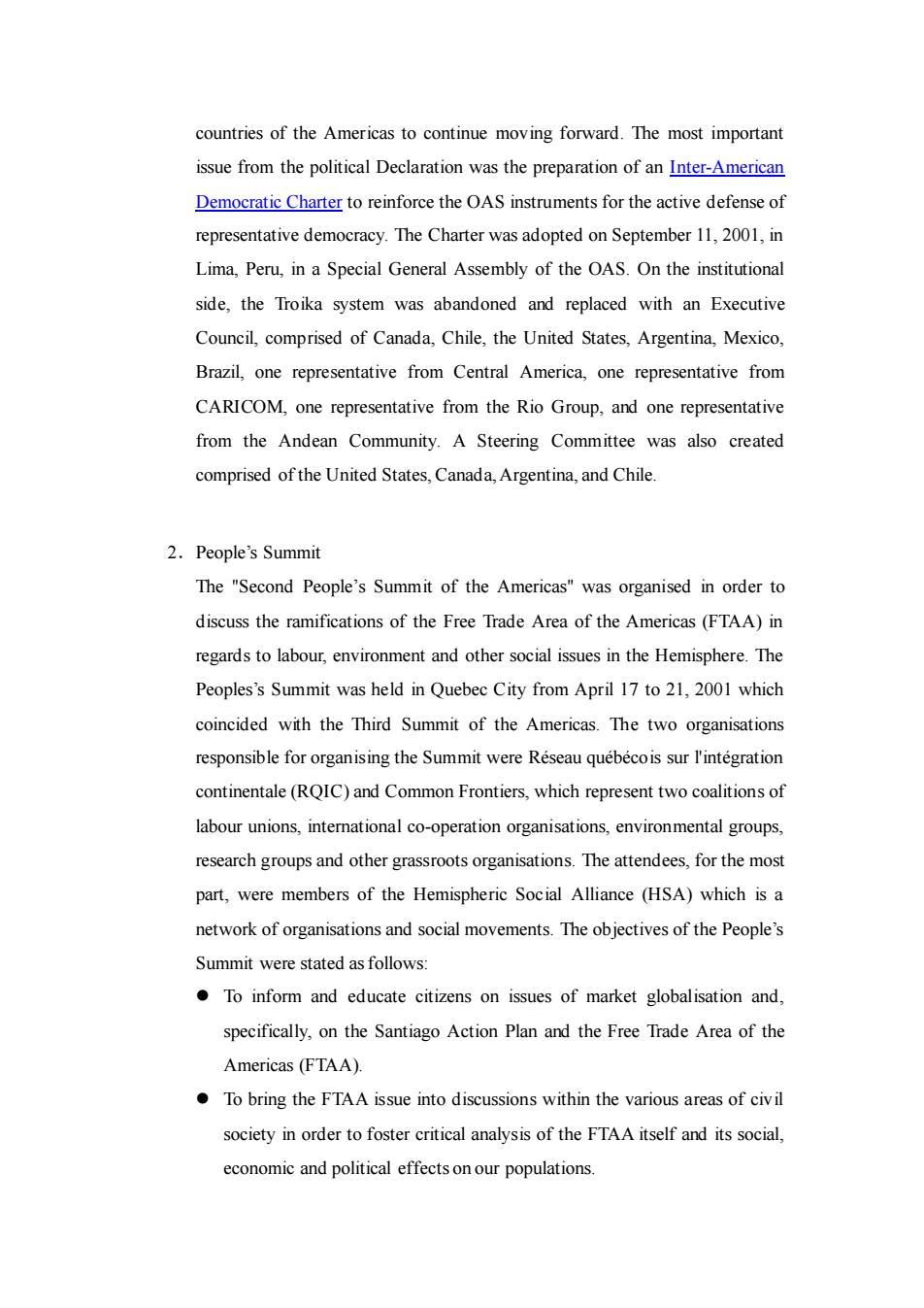
countries of the Americas to continue moving forward.The most important issue from the political Declaration was the preparation of an Inter-American Democratic Charter to reinforce the OAS instruments for the active defense of representative democracy.The Charter was adopted on September 11,2001,in Lima,Peru,in a Special General Assembly of the OAS.On the institutional side,the Troika system was abandoned and replaced with an Executive Council,comprised of Canada,Chile,the United States,Argentina,Mexico, Brazil,one representative from Central America,one representative from CARICOM,one representative from the Rio Group,and one representative from the Andean Community.A Steering Committee was also created comprised of the United States,Canada,Argentina,and Chile 2.People's Summit The "Second People's Summit of the Americas"was organised in order to discuss the ramifications of the Free Trade Area of the Americas(FTAA)in regards to labour,environment and other social issues in the Hemisphere.The Peoples's Summit was held in Quebec City from April 17 to 21,2001 which coincided with the Third Summit of the Americas.The two organisations responsible for organising the Summit were Reseau quebecois sur l'integration continentale(RQIC)and Common Frontiers,which represent two coalitions of labour unions,international co-operation organisations,environmental groups, research groups and other grassroots organisations.The attendees,for the most part,were members of the Hemispheric Social Alliance (HSA)which is a network of organisations and social movements.The objectives of the People's Summit were stated as follows: To inform and educate citizens on issues of market globalisation and, specifically,on the Santiago Action Plan and the Free Trade Area of the Americas(FTAA). To bring the FTAA issue into discussions within the various areas of civil society in order to foster critical analysis of the FTAA itself and its social, economic and political effects on our populations
countries of the Americas to continue moving forward. The most important issue from the political Declaration was the preparation of an Inter-American Democratic Charter to reinforce the OAS instruments for the active defense of representative democracy. The Charter was adopted on September 11, 2001, in Lima, Peru, in a Special General Assembly of the OAS. On the institutional side, the Troika system was abandoned and replaced with an Executive Council, comprised of Canada, Chile, the United States, Argentina, Mexico, Brazil, one representative from Central America, one representative from CARICOM, one representative from the Rio Group, and one representative from the Andean Community. A Steering Committee was also created comprised of the United States, Canada, Argentina, and Chile. 2.People’s Summit The "Second People’s Summit of the Americas" was organised in order to discuss the ramifications of the Free Trade Area of the Americas (FTAA) in regards to labour, environment and other social issues in the Hemisphere. The Peoples’s Summit was held in Quebec City from April 17 to 21, 2001 which coincided with the Third Summit of the Americas. The two organisations responsible for organising the Summit were Réseau québécois sur l'intégration continentale (RQIC) and Common Frontiers, which represent two coalitions of labour unions, international co-operation organisations, environmental groups, research groups and other grassroots organisations. The attendees, for the most part, were members of the Hemispheric Social Alliance (HSA) which is a network of organisations and social movements. The objectives of the People’s Summit were stated as follows: ⚫ To inform and educate citizens on issues of market globalisation and, specifically, on the Santiago Action Plan and the Free Trade Area of the Americas (FTAA). ⚫ To bring the FTAA issue into discussions within the various areas of civil society in order to foster critical analysis of the FTAA itself and its social, economic and political effects on our populations
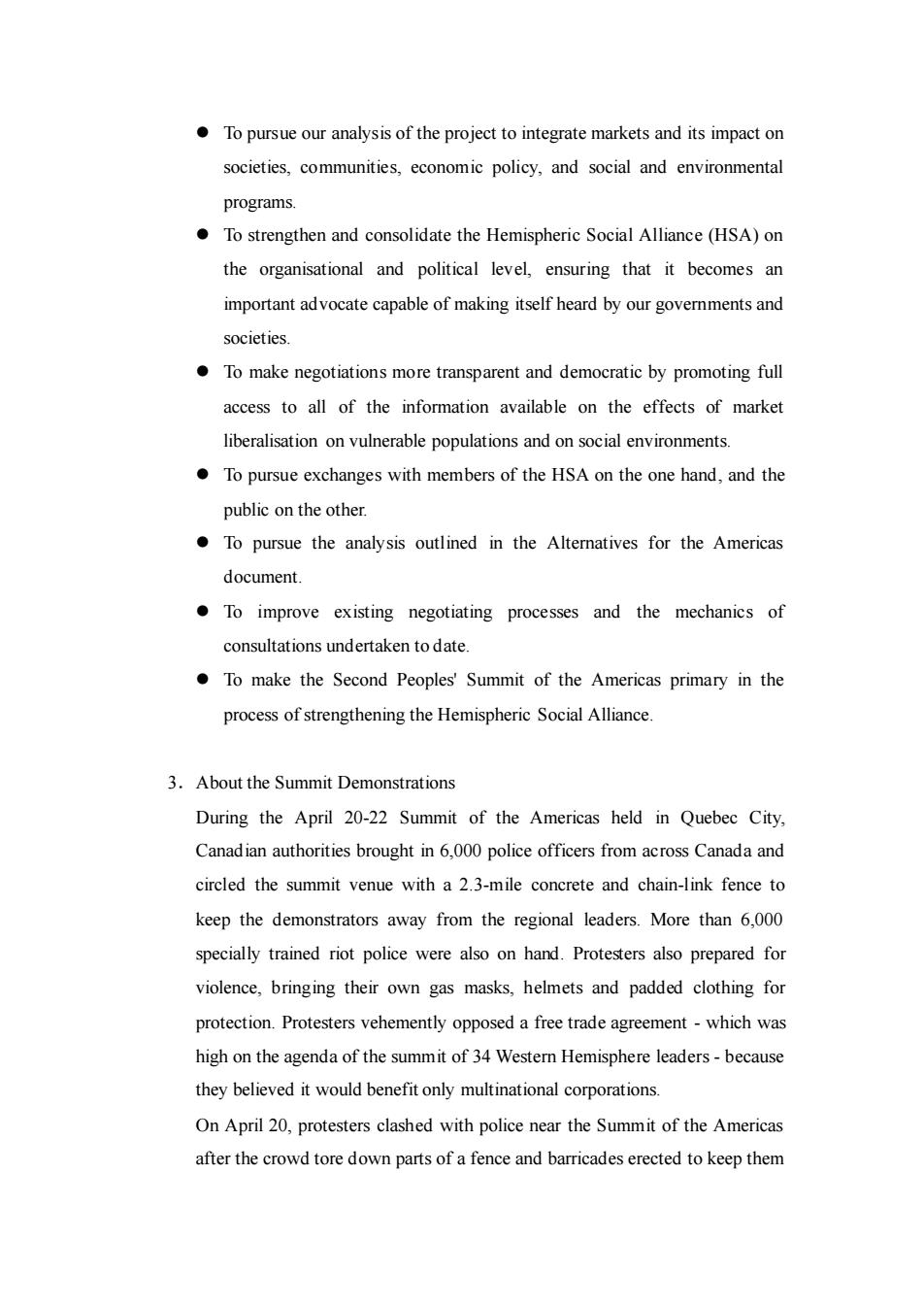
To pursue our analysis of the project to integrate markets and its impact on societies,communities,economic policy,and social and environmental programs To strengthen and consolidate the Hemispheric Social Alliance (HSA)on the organisational and political level,ensuring that it becomes an important ad vocate capable of making itself heard by our governments and societies To make negotiations more transparent and democratic by promoting full access to all of the information available on the effects of market liberalisation on vulnerable populations and on social environments. To pursue exchanges with members of the HSA on the one hand,and the public on the other. To pursue the analysis outlined in the Alternatives for the Americas document. To improve existing negotiating processes and the mechanics of consultations undertaken to date To make the Second Peoples'Summit of the Americas primary in the process of strengthening the Hemispheric Social Alliance. 3.About the Summit Demonstrations During the April 20-22 Summit of the Americas held in Quebec City, Canadian authorities brought in 6,000 police officers from across Canada and circled the summit venue with a 2.3-mile concrete and chain-link fence to keep the demonstrators away from the regional leaders.More than 6,000 specially trained riot police were also on hand.Protesters also prepared for violence,bringing their own gas masks,helmets and padded clothing for protection.Protesters vehemently opposed a free trade agreement-which was high on the agenda of the summit of 34 Western Hemisphere leaders-because they believed it would benefit only multinational corporations. On April 20,protesters clashed with police near the Summit of the Americas after the crowd tore down parts of a fence and barricades erected to keep them
⚫ To pursue our analysis of the project to integrate markets and its impact on societies, communities, economic policy, and social and environmental programs. ⚫ To strengthen and consolidate the Hemispheric Social Alliance (HSA) on the organisational and political level, ensuring that it becomes an important advocate capable of making itself heard by our governments and societies. ⚫ To make negotiations more transparent and democratic by promoting full access to all of the information available on the effects of market liberalisation on vulnerable populations and on social environments. ⚫ To pursue exchanges with members of the HSA on the one hand, and the public on the other. ⚫ To pursue the analysis outlined in the Alternatives for the Americas document. ⚫ To improve existing negotiating processes and the mechanics of consultations undertaken to date. ⚫ To make the Second Peoples' Summit of the Americas primary in the process of strengthening the Hemispheric Social Alliance. 3.About the Summit Demonstrations During the April 20-22 Summit of the Americas held in Quebec City, Canadian authorities brought in 6,000 police officers from across Canada and circled the summit venue with a 2.3-mile concrete and chain-link fence to keep the demonstrators away from the regional leaders. More than 6,000 specially trained riot police were also on hand. Protesters also prepared for violence, bringing their own gas masks, helmets and padded clothing for protection. Protesters vehemently opposed a free trade agreement - which was high on the agenda of the summit of 34 Western Hemisphere leaders - because they believed it would benefit only multinational corporations. On April 20, protesters clashed with police near the Summit of the Americas after the crowd tore down parts of a fence and barricades erected to keep them
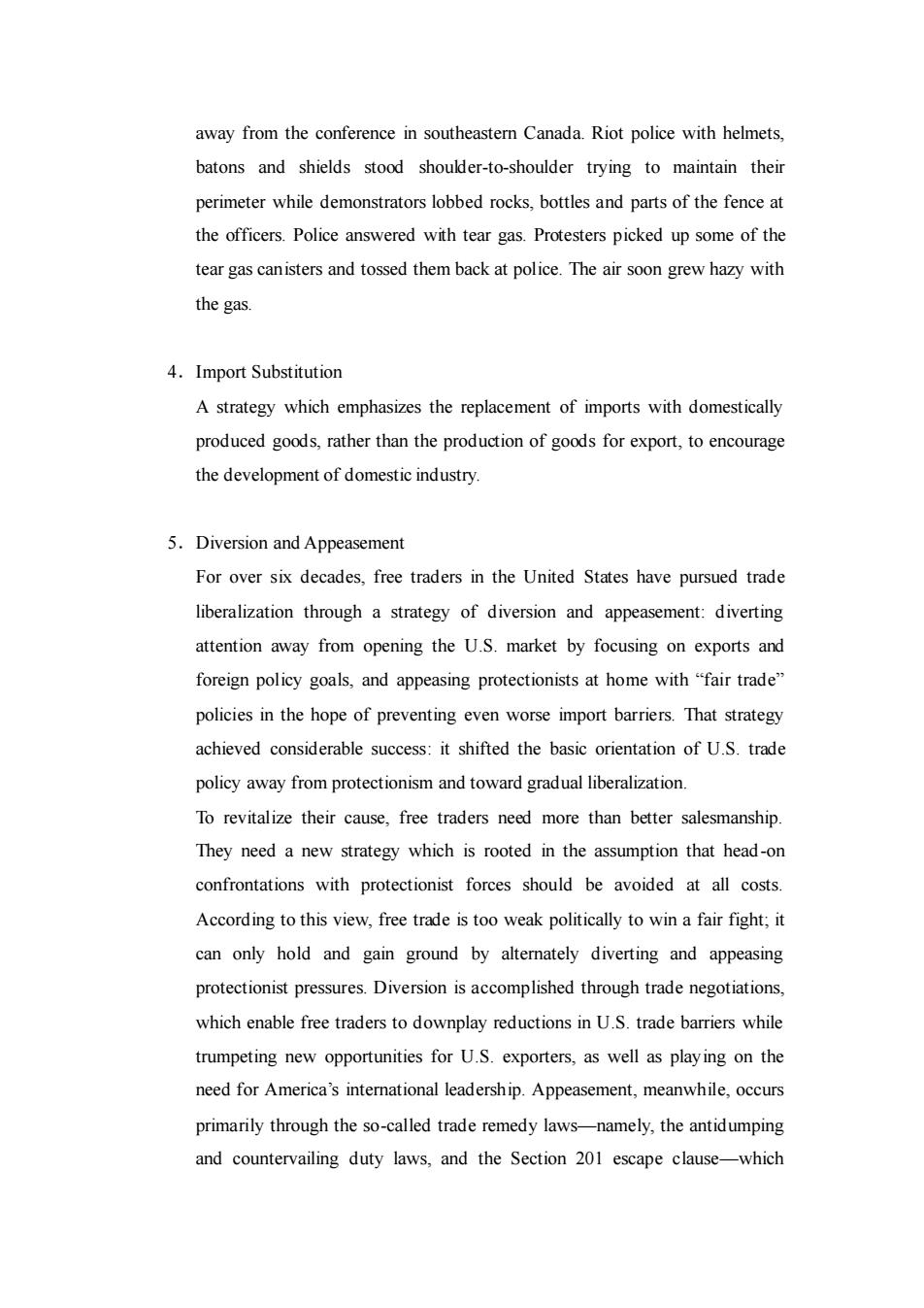
away from the conference in southeastern Canada.Riot police with helmets, batons and shields stood shoulder-to-shoulder trying to maintain their perimeter while demonstrators lobbed rocks,bottles and parts of the fence at the officers.Police answered with tear gas.Protesters picked up some of the tear gas canisters and tossed them back at police.The air soon grew hazy with the gas. 4.Import Substitution A strategy which emphasizes the replacement of imports with domestically produced goods,rather than the production of goods for export,to encourage the development of domestic industry. 5.Diversion and Appeasement For over six decades,free traders in the United States have pursued trade liberalization through a strategy of diversion and appeasement:diverting attention away from opening the U.S.market by focusing on exports and foreign policy goals,and appeasing protectionists at home with "fair trade" policies in the hope of preventing even worse import barriers.That strategy achieved considerable success:it shifted the basic orientation of U.S.trade policy away from protectionism and toward gradual liberalization. To revitalize their cause,free traders need more than better salesmanship. They need a new strategy which is rooted in the assumption that head-on confrontations with protectionist forces should be avoided at all costs. According to this view,free trade is too weak politically to win a fair fight;it can only hold and gain ground by alternately diverting and appeasing protectionist pressures.Diversion is accomplished through trade negotiations, which enable free traders to downplay reductions in U.S.trade barriers while trumpeting new opportunities for U.S.exporters,as well as play ing on the need for America's international leadership.Appeasement,meanwhile,occurs primarily through the so-called trade remedy laws-namely,the antidumping and countervailing duty laws,and the Section 201 escape clause-which
away from the conference in southeastern Canada. Riot police with helmets, batons and shields stood shoulder-to-shoulder trying to maintain their perimeter while demonstrators lobbed rocks, bottles and parts of the fence at the officers. Police answered with tear gas. Protesters picked up some of the tear gas canisters and tossed them back at police. The air soon grew hazy with the gas. 4.Import Substitution A strategy which emphasizes the replacement of imports with domestically produced goods, rather than the production of goods for export, to encourage the development of domestic industry. 5.Diversion and Appeasement For over six decades, free traders in the United States have pursued trade liberalization through a strategy of diversion and appeasement: diverting attention away from opening the U.S. market by focusing on exports and foreign policy goals, and appeasing protectionists at home with “fair trade” policies in the hope of preventing even worse import barriers. That strategy achieved considerable success: it shifted the basic orientation of U.S. trade policy away from protectionism and toward gradual liberalization. To revitalize their cause, free traders need more than better salesmanship. They need a new strategy which is rooted in the assumption that head-on confrontations with protectionist forces should be avoided at all costs. According to this view, free trade is too weak politically to win a fair fight; it can only hold and gain ground by alternately diverting and appeasing protectionist pressures. Diversion is accomplished through trade negotiations, which enable free traders to downplay reductions in U.S. trade barriers while trumpeting new opportunities for U.S. exporters, as well as playing on the need for America’s international leadership. Appeasement, meanwhile, occurs primarily through the so-called trade remedy laws—namely, the antidumping and countervailing duty laws, and the Section 201 escape clause—which
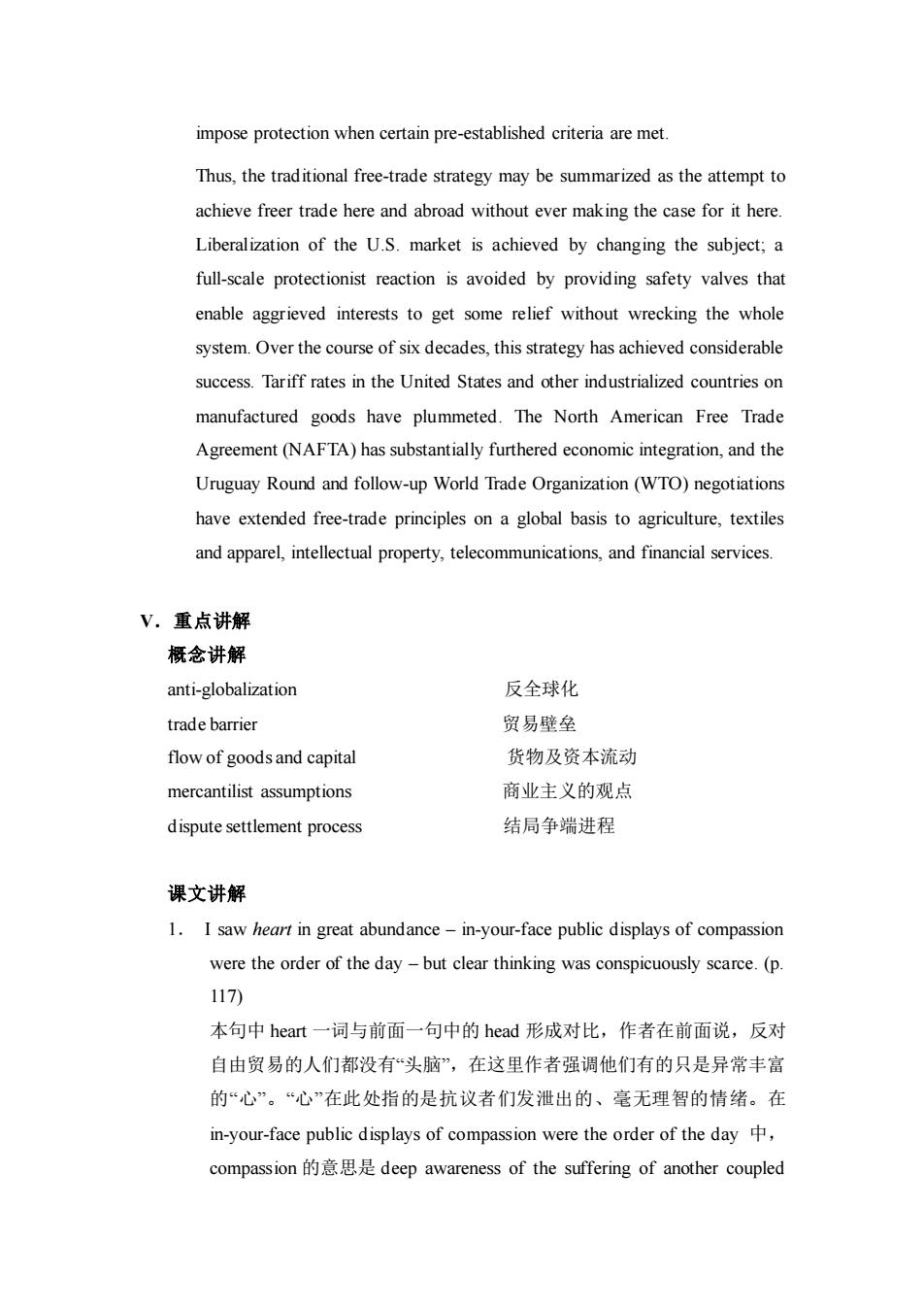
impose protection when certain pre-established criteria are met Thus,the traditional free-trade strategy may be summarized as the attempt to achieve freer trade here and abroad without ever making the case for it here. Liberalization of the U.S.market is achieved by changing the subject;a full-scale protectionist reaction is avoided by providing safety valves that enable aggrieved interests to get some relief without wrecking the whole system.Over the course of six decades,this strategy has achieved considerable success.Tariff rates in the United States and other industrialized countries on manufactured goods have plummeted.The North American Free Trade Agreement (NAFTA)has substantially furthered economic integration,and the Uruguay Round and follow-up World Trade Organization(WTO)negotiations have extended free-trade principles on a global basis to agriculture,textiles and apparel,intellectual property,telecommunications,and financial services. V.重点讲解 概念讲解 anti-globalization 反全球化 trade barrier 贸易壁垒 flow of goods and capital 货物及资本流动 mercantilist assumptions 商业主义的观点 dispute settlement process 结局争端进程 课文讲解 1.I saw heart in great abundance-in-your-face public displays of compassion were the order of the day-but clear thinking was conspicuously scarce.(p. 117) 本句中heat一词与前面一句中的head形成对比,作者在前面说,反对 自由贸易的人们都没有“头脑”,在这里作者强调他们有的只是异常丰富 的“心”。“心”在此处指的是抗议者们发泄出的、毫无理智的情绪。在 in-your-face public displays of compassion were the order of the day, compassion的意思是deep awareness of the suffering of another coupled
impose protection when certain pre-established criteria are met. Thus, the traditional free-trade strategy may be summarized as the attempt to achieve freer trade here and abroad without ever making the case for it here. Liberalization of the U.S. market is achieved by changing the subject; a full-scale protectionist reaction is avoided by providing safety valves that enable aggrieved interests to get some relief without wrecking the whole system. Over the course of six decades, this strategy has achieved considerable success. Tariff rates in the United States and other industrialized countries on manufactured goods have plummeted. The North American Free Trade Agreement (NAFTA) has substantially furthered economic integration, and the Uruguay Round and follow-up World Trade Organization (WTO) negotiations have extended free-trade principles on a global basis to agriculture, textiles and apparel, intellectual property, telecommunications, and financial services. V.重点讲解 概念讲解 anti-globalization 反全球化 trade barrier 贸易壁垒 flow of goods and capital 货物及资本流动 mercantilist assumptions 商业主义的观点 dispute settlement process 结局争端进程 课文讲解 1. I saw heart in great abundance – in-your-face public displays of compassion were the order of the day – but clear thinking was conspicuously scarce. (p. 117) 本句中 heart 一词与前面一句中的 head 形成对比,作者在前面说,反对 自由贸易的人们都没有“头脑”,在这里作者强调他们有的只是异常丰富 的“心”。“心”在此处指的是抗议者们发泄出的、毫无理智的情绪。在 in-your-face public displays of compassion were the order of the day 中, compassion 的意思是 deep awareness of the suffering of another coupled